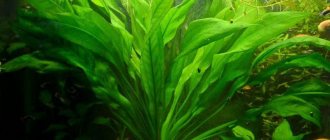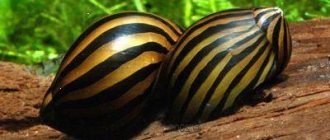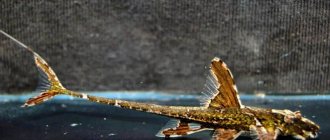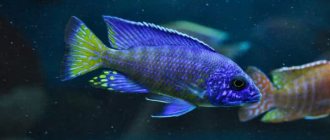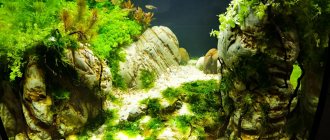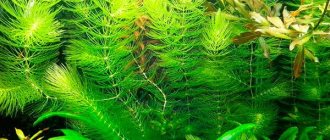4.3
(14)
When designing an aquarium, you definitely need to think about what plants will be in it. This is especially true in the first stages, when the balance has not yet been established, but you already want your home pond to look neat and well-groomed. Cirrus is perfect for such purposes. It grows quickly, creates large and dense thickets and does not require any special approach.
Botanical description of the plant
Aquarists value urut for its decorative qualities.
With proper care in the aquarium, the cirrus forms thickets that resemble lace. The plant is elastic. Under natural conditions, its stem adapts to the flow. It bends, and after a while it returns to its original form. Water yarrow appears to be strong at first glance, but in reality it is fragile. Cirrus is an aquarium plant that does not form a large number of branches. Each species has a characteristic color. At home, light green, emerald, and dark red species are grown.
The leaves of this exotic plant resemble feathers. They form refined whorls. Depending on the species, the color of the leaf blade can be light green, blue, or brownish.
The color depends on the conditions in which water milfoil grows. The shade of the leaves is affected by:
- water pH;
- water temperature;
- soil acidity.
Urut is a hydrophyte. An adult plant rises slightly above the surface of the water. At home, it is placed in an aquarium.
When an exotic crop grows, it forms unusual bushes that give an emerald shadow. Urut can be combined with cryptocoryne, placed in the center of a mini-reservoir.
Keeping uruti in an aquarium
Urut does not place high demands on living conditions; even beginners can grow it. The plant is placed in the background. It does well in a spacious aquarium.
In order for water yarrow to delight with amazing laces, you need to choose a suitable soil. Coarse sand should be poured into the aquarium; there should not be a lot of silt in it. The optimal layer thickness is 3 cm. If gravel is laid at the bottom of the mini-reservoir, you need to grow water yarrow in a small container. You should fill it with sand and place it along the side wall of the aquarium.
Freshwater culture develops favorably in slightly acidic water. The pH level should be within 6.
Do not allow dirt particles to settle on the leaves, otherwise the urut will not absorb nutrients well. A large amount of silt and dirt can lead to the death of the bush.
The amount of uruti affects plants
Varieties of freshwater crops
The plant takes root in warm and cool water. Cirrus, the species of which differ in color, is distributed almost throughout the globe.
- Variable flowering. The bush is found in the rivers of Spain and America. If it grows in natural conditions, it reaches a height of 1.3 m. The whorls have 5 leaves, the color of which varies from light to dark green. Cirrus varifolia prefers cold water. For full photosynthesis, the temperature must be no less than 18 and no more than 20 degrees.
- Brazilian. This species grows in the southern United States. Its height does not exceed 30 cm. The plant has an underdeveloped root system consisting of thin shoots. Brazilian water milfoil feels good in water with a temperature of + 23 degrees.
- Reed-like. The shrub grows in the rivers of Chile and Mexico. Its average height is 70 cm. The whorls have four leaves of green or bluish color. The exotic culture takes root in warm water, the temperature should be about 25 degrees.
- Variegated. A distinctive feature of the plant is its massive roots. It can be found in the rivers of North America. Under natural conditions, aquatic yarrow reaches a height of 1 m. Its stems are thin and elongated. Photosynthesis occurs at a temperature of plus 22 degrees.
- It flaunts in the ponds of North America, grows 1.5 - 2 m. The leaves of this species are dark, forming small whorls. The plant loves water whose temperature does not exceed + 20 degrees.
- Chapped. This variety is called tender urutya. It takes root in swampy areas and is common in Mexico and Cuba. The plant has a stem 50 cm high. The whorls fit tightly to each other and include 4 leaves. Exotic culture develops well at a temperature of + 23 degrees.
- Christmas tree. It grows in cold rivers of Chile and Mexico. The herringbone pinnate can be seen in northern Europe. It is distinguished by a hollow stem 1.5 m high. The leaves resemble needles, which is why the culture received its characteristic name. The recommended temperature for growing in an aquarium is +21 degrees.
- Redstem. The birthplace of this culture is sunny Cuba. It prefers to grow in rivers with crystal clear water. Red-stemmed pinnate loves warmth, but you can keep it in the same aquarium with cold-resistant plants. It is recommended to place it in water at a temperature of at least 25 degrees.
- Green. It produces beautiful flowers that are shaped like violets. Green pinnate has many varieties of white, red and blue colors. Feels comfortable in water at a temperature of +26 degrees.
Spiky
Clear, calm, slightly salty water is required. Should be pinched for bushiness. Good substrate for fish breeding. Does not tolerate high temperatures or dirt. Whitish stem (20-60 cm). Dark green leaves. Grows quickly. It dies off in winter.
Roraima
Simple in content. It has a beautiful unusual appearance: brown leaves with an orange tint on a red stem. Water should completely cover the plant; add more as it grows. Usually planted near the back wall of the aquarium.
Guayana
A new species, rarely seen. Small plant, slow growing, ideal for small aquariums. Periodic haircuts form a head. Delicate, breaks easily, so the proximity of large fish is not advisable.
Scabratum
Height 50 cm. Light green plant. Additional nutrients and filtration are required.
Proserpinacoides
Height up to 30 cm. Grows under and above water. The leaves are light green on the branches arranged in a herringbone pattern.
General information. Habitat
Red-stemmed pinnate is a natural variety of the Brazilian pinnate. The plant's homeland is considered to be North America, Cuba, and Mexico. In its natural habitat it grows in deep and shallow water with clean, clear water. If its level is very low, then the plant becomes emergent. Depending on the conditions, its appearance also differs slightly:
- In the air, the stem is erect, on which there are rugged, feather-like, green leaves with a glossy water-repellent surface.
- Under water, the leaf plates take on a more elegant appearance.
Regardless of where it grows, the stem turns brownish-red even in low light, which is a distinctive feature of this species. Other pinnates require bright light.
How to choose?
Already a general description of the various types of cirrus shows that some types are demanding in terms of keeping conditions, while others can be grown in any aquarium. For experienced breeders this does not matter much, but in the absence of proper qualifications you need to choose a simpler crop. You should also pay attention to the following points:
- required size of the aquarium;
- the composition of the fish inhabiting it;
- provided temperature and acidity of water;
- lighting characteristics;
- financial well-being of the breeder.
Red-stemmed pinnate: problems faced by aquarists
Aquarium plants are a link in maintaining biological balance
They require good maintenance, attention and care. Whether an experienced aquarist or a beginner, both are likely to encounter some problems when growing plants.
If this happens, you should pay attention to:
- Lighting – when choosing it, be sure to take into account the height of the aquarium. Cirrus is demanding of good lighting.
- The amount of CO2 supplied is the main building material for plant cells. The optimal gas concentration in an aquarium with this exotic culture is 15–30 mg/l.
- Daylight hours should be twelve hours.
- The presence or absence of fertilizing is a deficiency, as is an excess, harmful to the plant. It needs fertilizers in small quantities. However, if they added too much, this can be easily corrected by changing the water. And the deficiency can be compensated by additional application of complex fertilizer.
- Water parameters – the intensity of fertilizer consumption by plants, in particular CO2, depends on the level of acidity. And since this type of pinnate prefers an acidic environment and hard water, maintaining the acidity in the region of 6–7 is considered optimal.
- The quality of the soil may not be suitable for this type of plant.
Reproduction
Reproduction of the green Matogrossian pinnate occurs by vegetative means. To do this, you need to cut off the top part of the existing plant and plant it in the ground. Over time, it will take root and soon begin to grow.
If we talk about the financial side of the issue, then on the Internet, various sites selling pet supplies offer the described plant in the price range from 120 to 200 rubles per bush, which contains from three to five roots.
To summarize, it should be noted that the green cirrus matogrossii is a rare representative of aquarium plants, suitable for both beginner hobbyists and big professionals in the world of aquarium keeping. The combination of aesthetic splendor with tolerance for the possible conditions of the surrounding flora and fauna makes it one of the most attractive aquarium plant species that everyone should own.
What should the water be like?
Cirrus roraima prefers:
- soft and clean water,
- her restrained and soft movement;
- absence of mechanical impurities (otherwise they get clogged in finely cut leaves and pose a threat of rotting);
- relatively warm temperature (20-27o);
- pH value is within 6-8.
In such conditions, the plant, like the red-stemmed pinnate, has a beautiful brownish color, grows wildly with leaves and looks beautiful both in the center of the aquarium (as a definite accent) and along its perimeter.
Are there soil requirements?
To create the conditions the plant prefers, you need to pay attention to the quality of the soil. For example, the roraima pinnate or the Brazilian pinnate will be grateful for shallow soil that is slightly silted. You can try sand, preferably river sand, but don’t get carried away with changing it frequently or boiling it. It is better when there are certain inhabitants in the soil, the result of whose vital activity creates specific siltation.
Brazilian pinnate may not attach to the ground at all. It is capable of existing in a floating state. However, if thin, long root threads are visible in certain places, it is better to attach them to the ground. This will make it possible to give growth a certain direction.
Red cirrus is an option suitable for any aquarium. However, despite its unpretentiousness, the plant requires attention. The vulnerability of its leaves and the fragility of its stems should alert the aquarist to the seriousness of care and the need for constant monitoring of the water condition. But, having made friends with the plant, the aquarium will receive a worthy living decoration, and the owner will receive a lot of positive emotions.
Interesting fact
Lileopsis brasiliensis has a “stepbrother”. This is Lilaeopsis Mauritius. It grows naturally on the islands of Mauritius and was first discovered in the early 90s of the last century. It is very similar to Lileopsis from Brazil, but requires much lower light levels. This is what makes it attractive to aquarium designers. You can often find both plants growing at the same time. However, lilaeopsis is more often planted in a pot, which is equipped with a special weight for stability.
The New Zealand “colleague” does not like his neighbors. It grows well when alone in the aquarium.
Lileopsis brasiliensis is a variant of an aquarium plant that can be successfully used to decorate the foreground, create a composition for large-leaved bushes, and also create a natural atmosphere in a plant landscape.
Post Views: 2,987
Top dressing
Despite the fact that yarrow does not need additional feeding, since it receives everything from food and clean water, you can sometimes pamper it with complex liquid fertilizers, which will have a beneficial effect on the bush. For good growth with full roots, it is recommended to dig a ball at the roots, which is rolled out of clay. You can also add additional CO2. This feeding will make the color of the bush bright and saturated, and it will begin to grow faster.
We recommend reading about how to make your own fertilizers for aquarium plants.
Pistia, water salad
Pistia stratiotes
Araceae family – Araceae.
Homeland - tropical regions of Africa.
One of the most interesting floating plants. It produces large rosettes of velvety, wavy, bluish-green leaves. Large specimens reach a height of 15 cm, the diameter of the rosette of leaves can reach 25 cm. The root system of the plant is well developed and can descend to a considerable depth. In the interweaving of roots, the fry of many fish find an excellent refuge. Pistia is widely distributed among aquarium hobbyists. In the spring-summer period, the plant develops somewhat faster and reaches its maximum size. In winter, pistia grows worse.
Pistia should be kept in a tropical aquarium. The optimal water temperature is from 24 to 30 ° C. In colder water, growth slows down and the size of the plant decreases significantly. The characteristics of water - hardness and active reaction - do not matter much, but with a hardness of more than 12°, the pistia grows somewhat worse.
The root system of pistia perfectly purifies water by collecting turbidity particles. Water changes must be done 3-4 times a month.
The main requirement for keeping this plant is bright light. Pistia prefers natural and especially sunlight. With artificial lighting, the power of the lamps must be very high. Only fluorescent lamps should be used, the power of which should be at least 3 W per 1 dm2 of water surface. Even in relatively bright light, the plant is not as large as in natural conditions. It is not recommended to use incandescent lamps, as they generate a lot of heat and can cause leaf burns, even if they are located at a great distance from the plant. The duration of daylight should be at least 12 hours.
Air humidity is extremely important for pistia. Therefore, aquariums where it is grown must be tightly covered with glass or a special high cap, over which illuminators are placed.
The root system of pistia reaches a length of 25-30 cm. Most often, it does not reach the bottom, freely located in the water column, so the nature of the soil is not important for the plant. During periods of rapid growth, it is useful to fertilize with complex mineral fertilizers, which must include microelements. The amount of fertilizer applied to the water should be approximately the same as for most other plants - about 1.5-2 g of dry matter per 100 liters of water weekly.
Under favorable conditions, pistia reproduces rapidly by forming daughter lateral shoots, which can be separated from the mother plant after the formation of 2-3 small leaves.
In poor lighting, the size of the pistia is significantly reduced, and young leaves do not rise above the surface of the water. When the water temperature drops, the plant may die. If in winter it is impossible to create optimal conditions for the plant, it can be placed in a humid chamber and kept there on a cushion of bog moss at a temperature of 12-14 ° C. The overwintered plant is placed in an aquarium in the spring and kept at high temperatures and strong light.
Possible diseases and their treatment
Sometimes the uruti begins to stretch the stem, and the foliage falls off. To cope with this problem, you need to improve lighting. But when too much algae appears, it means that the ornamental shrub is suffering from direct sunlight. Loss of decorative properties is usually associated with water pollution. The fragile succulent foliage of the pinnate attracts many herbivorous fish.
If the plant is not grown for feeding them, you should stop breeding such species. When the lighting is in order, but the urut is still weakening, you need to check other versions - first of all, lack of carbon dioxide. It is worth noting that it will not be possible to compensate for the lack of light by supplying more carbon dioxide (and vice versa). It is also necessary to very carefully control the proportions of macro- and microfertilizers.
Conditions for growing an aquarium “Christmas tree”
The greatest depth at which the plant can live is 15.5 meters. However, as a rule, the grass itself chooses its preferred depth level.
Can grow in an aquarium all year round. Does not tolerate direct sunlight, sheds leaves when there is a sharp change in conditions, and withers in poor lighting. The optimal temperature for keeping it is +18… +28 degrees. The warmer the water, the faster the plant will grow.
The water in which hornwort grows should have a hardness of 5-15° and an acidity of 7-7.5 pH (some species can withstand 9 pH).
The required lighting is 0.4-0.5 W per liter. Daylight hours in the aquarium should be maintained for 12-14 hours. Shelter from direct sunlight must be required.
Important! It is necessary to prevent the hornwort from experiencing sudden changes in the parameters of the water where it lives. If the plant is grown in optimal conditions, it will produce an increase of 15-20 cm per week.
Kinds
There are many varieties of this plant. However, the most popular types are:
Cirrus red matogrossii. An adult bush reaches a height of about 60 cm. On one whorl there are 5-7 leaves, the length of which is about 5 cm. The plant is quite unpretentious. It is distinguished by its red or brown color, due to which it contrasts with the rest of the underwater flora in the aquarium;
Brazilian. Suitable for containers of any size. Has a rich green color. Loves bright lighting with an intensity of about 0.5 W/l. It grows well all year round, but in winter you can slightly reduce the temperature, giving the plant a rest. In general, conditions of detention are standard;
Redstem. In fact, this is a subspecies of the previous plant. It grows naturally in the tropical swamps of South America. It has a reddish stem, and its color remains regardless of lighting. In other species, redness appears only in intense light. Planted in the middle or background;
Roraima. It is named after the state in Brazil where it grows. The leaves are brown-orange and the stem is red-brown. Thanks to this, the bushes look good against the background of other flora. The plant reaches a height of 50 cm. The width is about 6 cm;
Christmas tree. Visually it is not particularly different from other varieties. It has many thin leaves on a large stem. The color is light green. The root system is weak. Loves bright lighting, including natural, diffused lighting, but it is better to avoid direct sunlight;
Guayana. Also bright green pinnate. The stem branches strongly, due to which it forms dense thickets. This plant is compact and does not take up much space in the aquarium;
Cirrus caudate. It grows naturally in the eastern regions of the United States. Prefers shallow water in lakes, swamps and river backwaters. Visually similar to the Matogros and Brazilian species. The stem is erect, branches weakly. It can be either green or red. Depending on the lighting.
How to plant a plant
Sometimes you can come across recommendations that to plant hornwort it needs to be strengthened in the ground. There is no need to do this. Because there is a risk that the part buried in the soil will begin to rot.
To plant, you just need to throw a piece of the stem with the top into the water. The plant will begin to grow on its own and take the place in the aquarium that seems most suitable for its development.
If you want the hornwort to grow like an ordinary plant, not in a floating, but in a purely vertical position, then it can be tied to a snag, a stone, or a sucker, so that all parts are open. When tying, you should not forget that this aquarium grass is very fragile.
Povoynichek
Elatine macropoda forma submersa
The warbird family is Elatinaceae.
The homeland of this attractive plant is France, Spain, North Africa, the islands of Malta and Sicily. Under the soil, it is enough to have a mixture of fine sand and weathered clay. During growth it needs rest. In particular, fish that eat algae and plants should not be allowed into the aquarium at this time, as they can tear out and destroy the seedlings. When planting, it is advisable to divide the bush into two or several parts to facilitate the formation of turf. This method of planting provides protection for fish eggs that sink to the bottom. Loves bright, whenever possible sunlight. The rays must penetrate to the bottom. Prefers temperature 15-30°C. The plant is unpretentious regarding the composition of water.
Rules of care
Hornwort is an aquarium plant that is easy to maintain. The main maintenance measure will be periodic washing of the Christmas tree from contamination.
The stem is carefully removed from the water and placed under running water with a gentle stream. The plant is then returned to the aquarium.
Important! Since the stems of hornwort are very large, during the washing procedure you should be extremely careful not to break or damage them. If the plant does break, then its upper part can be replanted. Because hornwort can quickly form strong thickets that will interfere with the growth of other plants and the swimming of large fish, they will need to be thinned out. This procedure is done with scissors. At the same time, old plants are cut out.
You need to change the water in an aquarium where hornwort grows once a week. Add ¼ of the total volume of water that has been standing for at least a week.
Once it reaches the top of the water surface it will need to be cut back and replanted.
If any part of the plant falls off or breaks off, it must be removed from the aquarium in a timely manner to prevent rotting.
This aquarium grass does not require any other care.
Fir-tree pinnate or Urut fir-tree (Myriophyllum aquaticum “Green”)
Good day, dear aquarists! So I finally launched my small 80 liter aquarium. This is my first aquarium, and I hope not the last.
Equipment: External filter, JBL e702 GreenLine. Heater: JBL ProTemp s 50. Light – two Ptero Ray 1700/25-30 strips of 1700 Lumens each. Ptero-Aquaplanner – Aquarium lighting controller. CO2 – Sicce co2 life. Replaced it with DIY CO2 D601 4 liters. APC SurgeArrest P1T-RS surge protector
Soil and chemistry: AQUAYER Living soil, 10 l. AQUAYER Complex No. 1, from the 5th week began to add complex No. 2. AQUAYER Biostarter. AQUAYER AntiToxin+K
Plants: Foreground. 1. Tiny Sitnyag (Eleocharis parvula). 2. Sagittaria.
Transition to the middle shot of the design near the driftwood with stones. 1. Alternanthera reineckii sp. 'Mini'. 2. Staurogyne sp. 3. Cardamine lyrata, removed Bucephalandra sp. instead. Shine Green, Sokan. 4. Anubias barteri var. nana
Middle plan left side. 1. Cryptocoryne wendtii brown. 2. Blyxa japonica. 3. Carolina cabomba.
Medium shot right side. 1. Ludwigia super red (Ludwigia palustris “super red”). 2. Carolina Bacopa 3. Flame Moss, Taxiphyllum species. 4. Rotala macrandra.
Background right side. 1. Christmas tree pinnate (Myriophyllum elatinoides). 2. Proserpinaka. 3. Eleocharis sp. “Xingu.
Background left side. 1. Roraima pinnate (Myriophyllum sp. Roraima). 2. Bacopa monnieri. 3. Didiplys. 4. Eusteralis narrow leaf.
Population: 1. Ramirezi apistograms – 5 pcs. 2. Glass catfish – 5 pcs. 3. Dermogenis – 4 pcs. 4. Sterba corridors – 5 pcs. 5. Red neons – 10 pcs. 6. Amano shrimp – 10 pcs., other types will most likely be gray
Water supply parameters: Vodogon “Dniester-Chernivtsi” Hidden text
I bought soil, chemicals and plants from Bahmut. I gave the second issue of AQUAYER fertilizer as a gift, thank you, very nice. – https://www.aquaforum.ua/showthread.php?t=216886 plants – https://www.aquaforum.ua/showthread.php?t=63121 The plants are all in great healthy shape, I hope I won’t ruin them.
Difficulties in growing
Some aquarists, growing hornwort, are faced with the fact that it periodically crumbles, and try to find out what the reason is. This plant behavior is usually observed when water parameters, such as acidity, change dramatically. For the same reason, the “herringbone” can rot.
If such a problem occurs, you need to cut off the entire tops for further propagation. Remove and discard stems with fallen leaves.
The Christmas tree can grow poorly and look unhealthy in clean, organic-free water, as well as in insufficient lighting.
It is better to keep fish in an aquarium by decorating it with natural plants rather than artificial ones. Firstly, it looks much more beautiful and natural, and secondly, it will be much more useful for the aquarium inhabitants, they will feel more comfortable among them. Hornwort is an excellent solution for decorating an aquarium. With it you won’t have to deal with a lot of hassle, and it can grow successfully even in Spartan conditions. In addition, the plant will be your reliable assistant in maintaining cleanliness in the aquarium as a mechanical filter and saturating the water with the necessary oxygen.
Sources
- https://rybki.guru/rastenija/peristolistnik.html
- https://aquamir-za-steklom.ru/akvariumnye-rasteniya/katalog-akvariumnykh-rasteniy/peristolistnik-matogrosskiy-zelenyy.html
- https://MrHvost.com/peristolistnik
- https://vplate.ru/akvariumnye-rasteniya/peristolistniki/
- https://aqhome.ru/peristolistnik-matogrosskiy-zelenyy-myriophyllum-matogrossense-green
- https://myaquas.ru/rasteniya/peristolistnik-krasnyj.html
- https://pets2.me/bok/1705-peristolistnik-kak-uhazhivat-v-akvariume.html
- https://aquazoom.ru/plant/plant.php?in=1374
- https://pets2.me/bok/36-kak-uhazhivat-za-rogolistnikom-v-akvariume.html
How do you like the article?
Genus Myriophyllum-3
Subclass Rosidae (Rosidae)
Order Haloragales (Haloragales)
Family Haloragaceae
Genus Cirrus - Myriophyllum.
Miriophyllum mezianum - Myriophyllum mezianum.
Myriophyllum mesianum requires both high levels of light and CO2 supplementation for full growth. The soil is nutritious, temperature above 25°C. Although it was found in nature in soft water, it can live just as well in water of medium hardness. Growing underwater, myriophyllum widely spreads its bright green leaves-twigs on reddish stems. The upper leaves become wider towards the top, forming a cone-like shape.
You need to plant the plants a couple of centimeters apart from each other, in small groups in the middle plan of the aquarium. Compared to other aquarium plants, a grove of myriophyllum twigs looks very beautiful. This plant will need to be trimmed very, very rarely. Only after the plant gets used to its new place of residence can you give the Myriophyllum mesianum thickets the shape you need. Propagated by cuttings and side shoots.
Cirrus (Urut) fir-tree, grass-like - Myriophyllum elatinoides.
The plant is intended for cold, unheated aquariums; it loves clean, clear water and grows well at high water levels. Cirrus is planted in groups, so that the light reaches the lower leaves. Temperature 18-24°C and below, water is not very hard up to 12°, the reaction is neutral. The plant does not tolerate hard water well. They should not be placed in aquariums where they are at risk from mud particles floating in the water. For their thin leaves, there is nothing more dangerous than dirt settling on the green surface - the leaf simply suffocates. Requires weekly water changes in the aquarium and powerful filtration. Can be propagated by cuttings.
Pinatum pinnatum, chipped. Tender urut - Myriophyllum pinnatum.
“2” The temperature of the content is higher than that of other species, pH 6.5-7.5, dH 5-15°. Regular water changes are required. The lighting is strong, prefers the addition of CO2.
“4” The root system is powerful. Loves nutritious soil, fertilizing with fertilizers rich in iron and microelements.
“5” In the background, the perennial plant looks bad; it is better to plant it in the middle ground, because The plant is not bright. The plant grows quickly in good conditions. Due to its branching and irregular growth, it is recommended for aquariums with viviparous fish. Disadvantages: this periofolia is prone to algae fouling. When the water level decreases, it transforms into an emergent plant. They should not be placed in aquariums where they are at risk from mud particles floating in the water. For their thin leaves, there is nothing more dangerous than dirt settling on a green surface. Planting density - 5 plants per 20 cm2.
“6” Any part of the plant that has adventitious roots can serve as a green cutting. You can also separate and plant numerous side shoots.
Description of the Hydrocharitaceae family, Hydrilla verticillata.
The last changes and additions were made on May 14, 2013.

